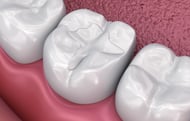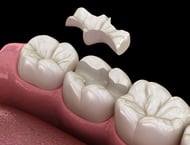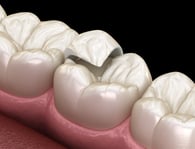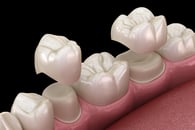There are several restorative options to treat a damaged or decayed tooth, including fillings, inlays, onlays, and crowns. This blog explores the differences between these options.
Fillings
 A filling is the most common and basic dental restoration. When a tooth develops a small hole or a cavity, a filling is used to fill the hole and seal it to prevent the cavity from getting bigger. Fillings can be made from a variety of materials, like amalgam, gold and composite resins, and are the most affordable, fast, and effective treatments for minor tooth decay available.
A filling is the most common and basic dental restoration. When a tooth develops a small hole or a cavity, a filling is used to fill the hole and seal it to prevent the cavity from getting bigger. Fillings can be made from a variety of materials, like amalgam, gold and composite resins, and are the most affordable, fast, and effective treatments for minor tooth decay available.
Inlays
 Inlays are usually needed when the cavity inside the tooth is too large and too deep. Unlike a filling that uses a composite material to fill the space and only takes one visit, with an inlay, a solid piece of material (e.g. porcelain, ceramic, or gold) is made in a laboratory to precisely fit inside the empty space. Unlike fillings, inlays hold for a significantly longer time without shrinkage or staining, and they are also more aesthetically appealing.
Inlays are usually needed when the cavity inside the tooth is too large and too deep. Unlike a filling that uses a composite material to fill the space and only takes one visit, with an inlay, a solid piece of material (e.g. porcelain, ceramic, or gold) is made in a laboratory to precisely fit inside the empty space. Unlike fillings, inlays hold for a significantly longer time without shrinkage or staining, and they are also more aesthetically appealing.
Onlays
 Unlike fillings and inlays, onlays are used to restore a larger part of the tooth. The area an onlay covers involves one or more of the cusps of your tooth, whereas, inlays and fillings cover the area inside of your tooth between the cusps. Like inlays, onlays are fabricated in the dental laboratory and, therefore, more than one patient visit is required to complete the restoration. As with inlays, onlays are more durable and match your teeth better than composite fillings. Onlays also don't require removal of significant tooth structure like crowns do.
Unlike fillings and inlays, onlays are used to restore a larger part of the tooth. The area an onlay covers involves one or more of the cusps of your tooth, whereas, inlays and fillings cover the area inside of your tooth between the cusps. Like inlays, onlays are fabricated in the dental laboratory and, therefore, more than one patient visit is required to complete the restoration. As with inlays, onlays are more durable and match your teeth better than composite fillings. Onlays also don't require removal of significant tooth structure like crowns do.
Crowns
 A dental crown is the largest restoration out of the four, as it covers the entire tooth surface above the gum line. Crowns are necessary when there is significant damage to the tooth and the natural tooth structure is no longer enough to support everyday chewing. Crowns can also be made to cover misshapen or discolored teeth and to cosmetically enhance your smile.
A dental crown is the largest restoration out of the four, as it covers the entire tooth surface above the gum line. Crowns are necessary when there is significant damage to the tooth and the natural tooth structure is no longer enough to support everyday chewing. Crowns can also be made to cover misshapen or discolored teeth and to cosmetically enhance your smile.
At the first visit, your dentist will prepare the tooth by grinding it down if necessary, take impressions, and place a temporary crown. Like inlays and onlays, crowns are then fabricated in a dental laboratory to resemble your natural teeth, and can be made from stainless steel, all metal (such as gold or another alloy), porcelain-fused-to-metal, resin, or ceramic. The permanent crown is cemented about two weeks after the first appointment.
This is not a comprehensive list of dental procedures. Other restorations such as bridges, implant crowns, 3/4 crowns, dentures, and veneers are also available. Contact our office at (925) 705-7093 to schedule a consultation and we can go over the best options for you.


.jpg?width=712&name=GSD-Scalloped-Tongue-Causes-and-Treatment-Blog-01.27.2210.21.21%20(1).jpg)











.jpeg?width=425&name=GSD-How-to-Combat-Dental-Plaque-07.22.24-2%20(1).jpeg)



